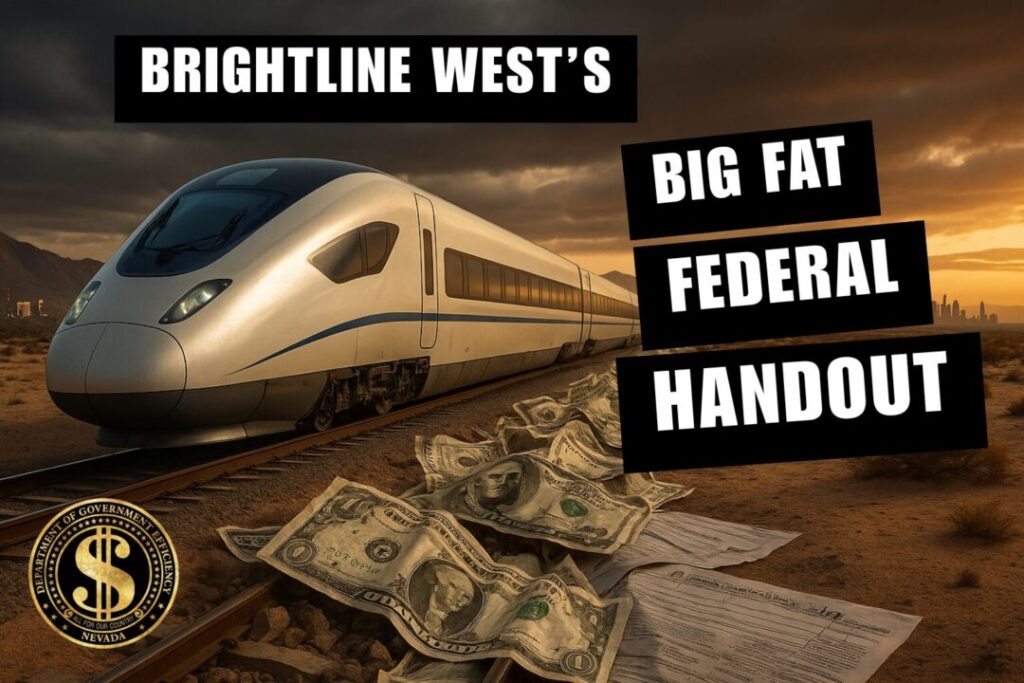(DOGE NEVADA Staff) – Brightline West once promised to build America’s first true high-speed rail line — from Las Vegas to Southern California — with private money. No handouts. No taxpayer burden.
That promise didn’t last long.
According to the Las Vegas Review-Journal, Brightline West, backed by Fortress Investment Group, just applied for a $6 billion federal loan from the U.S. Department of Transportation’s Build America Bureau.
The company confirmed the request on September 26, 2025 — and quietly admitted the project’s total cost has ballooned to about $21 billion, nearly double what was first advertised.
What Happened to “Privately Funded”?
When Brightline West was first pitched, company officials and Nevada boosters said it would be built mostly with private investment and tax-exempt bonds — not direct taxpayer dollars.
That helped sell the idea politically. It sounded like a free market project that just needed a green light, not a blank check.
But as costs climbed, the funding story changed.
So far, Brightline West has:
-
Secured $3.5 billion in federal tax-exempt Private Activity Bond allocations.
-
Received a $3 billion federal grant earlier this year.
-
Now filed for a $6 billion federal loan on top of that.
Add it up, and nearly half the financing now depends on taxpayer-supported tools.
A $21 Billion Question
So why the sudden jump from $12 billion to $21 billion? Brightline West hasn’t said.
A company spokesperson told reporters the figure was correct but declined to explain the spike.
Sources point to inflation in construction materials, higher right-of-way costs, and fancier station designs.
That may be true, but critics say it’s also a familiar Washington story — projects start out “cheap and private,” then morph into massive taxpayer liabilities once shovels hit the ground.
Nevada’s Stake
For Nevadans, this isn’t just a California story.
The train’s northern end would sit near the Las Vegas Strip, with thousands of construction jobs and future tourism dollars on the line.
State leaders, including Governor Joe Lombardo, have generally supported the concept because it could relieve I-15 traffic and attract visitors who might otherwise drive or fly.
But as the project’s price climbs, so does the risk that taxpayers will be left holding the bag.
Nevada’s economy has been hammered before by half-finished megaprojects — from stalled resorts to overpriced public works.
If federal loans or grants prop up Brightline West and the numbers don’t pencil out, taxpayers from Reno to Laughlin could end up subsidizing a rail line few locals will ever ride.
What Supporters Say
Backers argue the project will reduce traffic, cut carbon emissions, and link two of the nation’s busiest tourist regions with 200-mph trains.
Brightline West says it expects to start construction soon and complete the line before the 2028 Los Angeles Olympics.
Supporters also point out that federal infrastructure programs exist precisely to spur projects like this — private-public partnerships that, in theory, pay for themselves over time.
Critics Aren’t Buying It
Skeptics in both parties are asking why a “private” company needs billions in taxpayer-backed aid.
Some watchdogs see it as Amtrak 2.0, with better marketing.
If the line fails to attract enough riders, the government could be left guaranteeing debt it never planned to cover.
That’s the danger of “blended finance” — when a private project leans on public dollars but keeps profits private.
Brightline Has Gone Off The Rails
Nevadans have seen this movie before: big promises, bigger numbers, and eventually a request for more federal help.
No one disputes that faster travel between Las Vegas and Los Angeles sounds great.
The question is who pays when the dream costs twice as much as promised.
If history is any guide, the folks footing the bill won’t be riding in first class — they’ll be the taxpayers watching their money speed out of town.
The opinions expressed by contributors are their own and do not necessarily represent the views of Nevada News & Views. This article was originally published via DOGENV.com.



